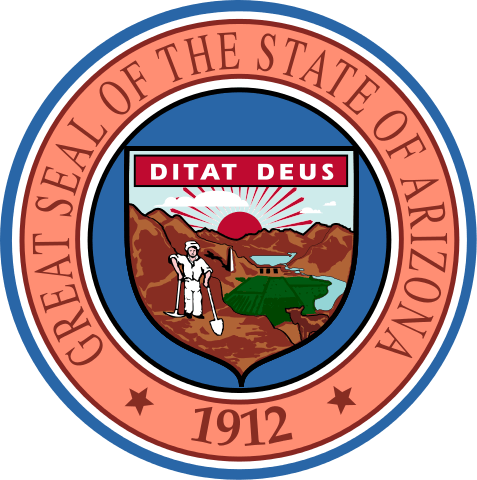Arizona is a state in the southwest of the United States ; the abbreviation is AZ. Arizona is nicknamed Grand Canyon State. Its capital is Phoenix.
| Area | 295,254 km² |
| Residents | 6,931,071 |
| Residents per km² | 23.5 |
| Capital | Phoenix |
| Postal Code | AZ |
| ISO-3166-2 code | US-AZ |
| FIPS code | 04 |
Also known as Grand Canyon State, Arizona is short for AZ with a population of 5,130,632. The capital city and the biggest city of Arizona is Phoenix.
Geography
Throughout the south bordering Arizona to Mexico. Otherwise the border is domestic. It is bordered by California to the southwest and Nevada to the northwest. In the north, the border with Utah runs towards Four Corners ‘ Point, the only four-country corner in the United States and one of the few in the world. There Arizona meets Colorado in the extreme northeast and shares the eastern border completely with New Mexico.
Arizona belongs to two natural areas. The northeast of the state lies on the Colorado Plateau, all other parts of Arizona belong to the Basin and Range region. The border is formed by the Mogollon Rim mountain range .
The Colorado River and the Grand Canyon it formed separates the Arizona Strip from the rest of the state in the northwest. It also forms almost all of Arizona’s western border with Nevada and California. Other major rivers in Arizona include the Little Colorado River in the northeastern state and the Gila River and its tributaries in central and southern Arizona.
Climate
In Arizona there is a dry desert and semi-desert climate, in the north it is more of a steppe climate. This means that, depending on the altitude, there are relatively mild winters and hot summers. Because of the proximity to the Rocky Mountains, there are usually large temperature differences between day and night. The average rainfall is between 100 and 500 mm per year, with most of the rain falling between July and November. In addition, the city of Yuma is one of the sunniest places in the world with around 4,000 hours of sunshine annually. On the other hand, the city of Flagstaff, located at around 2,135 meters in the north of the state, is one of the most important winter sports locations in the United States.
Flora and fauna
Because of the drought, Arizona has many cacti, palm lilies, and mesquite trees.
The largest wildlife species include white tailed deer and mule deer, as well as elk, pronghorn and bighorn sheep. A few bears still live in remote areas. Predators such as pumas, jaguars, badgers and other marten-like animals live in the mountain regions. There are many species of lizards, spiders, and snakes in the Sonoran Desert.
History
In the period from 300 to around 1200, the Hohokam culture was in southern Arizona .
The actual colonization of Arizona began around 1540 by Catholic-Spanish missionaries. They began to convert the Indians to the Catholic faith. Soon after, the Spaniards founded the first fortified cities (1752 Tubac, 1775 Tucson ). After Mexican independence in 1821, Arizona became part of Mexico.
In 1848, after its defeat in the Mexican-American War, Mexico had to cede all areas north of the Gila River to the USA by the Treaty of Guadalupe Hidalgo for a payment of 15 million dollars. This area extended over the present-day states of Arizona, New Mexico, California, Nevada, Utah, the western part of Colorado and the southwestern part of Wyoming. In 1853, with the Gadsden purchase of Mexico for 10 million US dollars, another area of 77,700 km² south of the Gila River was acquired
On February 28, 1859, the first Indian reservation, the Gila River Indian Reservation, for the Pima and Maricopa Indians was established in the Arizona Territory. On June 1, 1868, the United States’ largest reservation, the Navajo Nation Reservation, was established by a treaty between the United States and the Navajo (Diné) State.
On February 14, 1912, Arizona was established as the 48th state as a self-governing state. The upgrading is due not least to the Arizona Rangers, who liberated Arizona from excessive lawlessness through active efforts (1901 to 1909).
Economy
Real gross domestic product per capita GDP – the most important indicator of prosperity – was USD 43,709 in 2016 (national average of the 50 US states: USD 57,118; national ranking: 44). The unemployment rate was 4.3% in November 2017 (national average: 4.1%). Arizona is one of the poorer states in the United States.
In addition to irrigation crops (citrus fruits, cereals, cotton, winter vegetables), the main products of agriculture are cattle farming. The largest farms in the United States can be found in Arizona. Copper ore mining, coal, petroleum and fine electronics are important. Arizona is of great importance as a travel destination.

